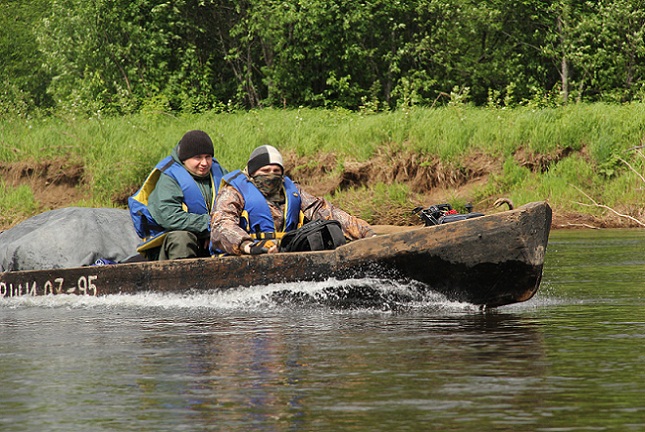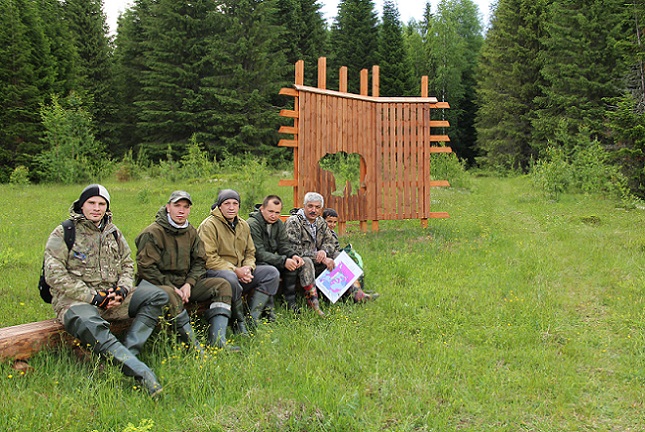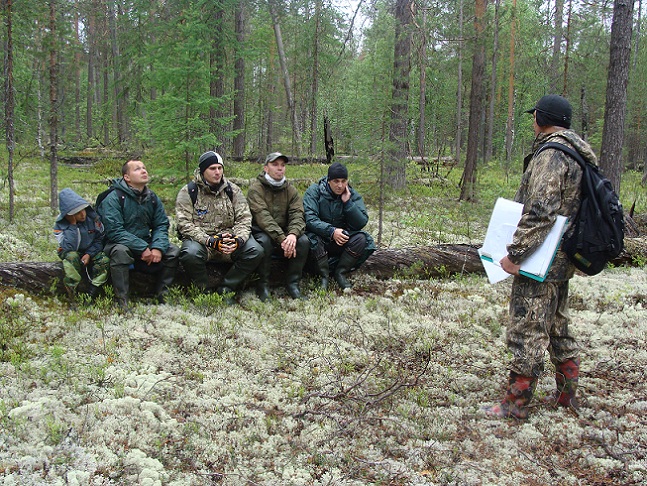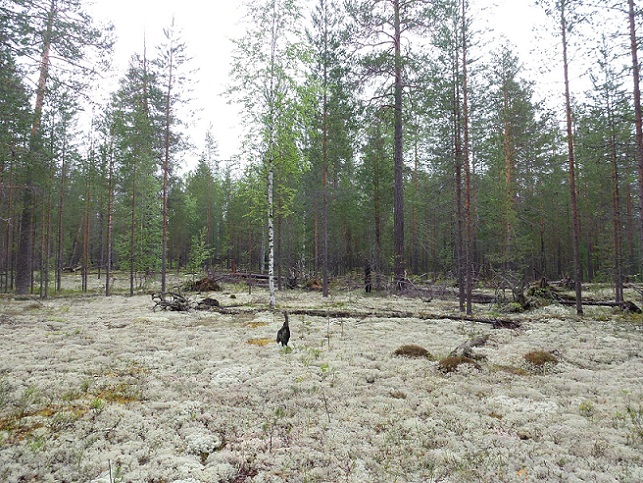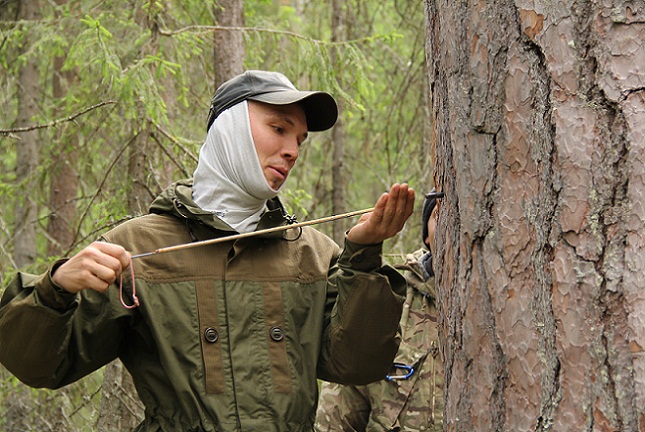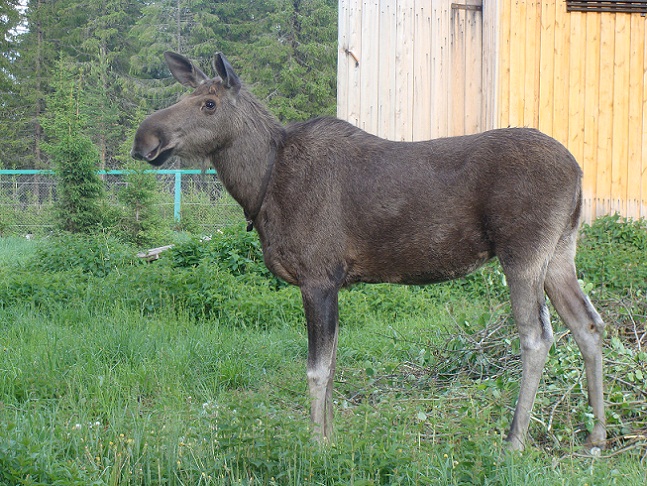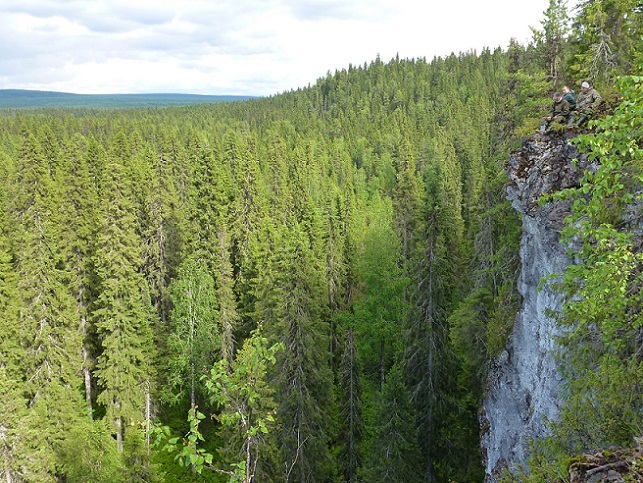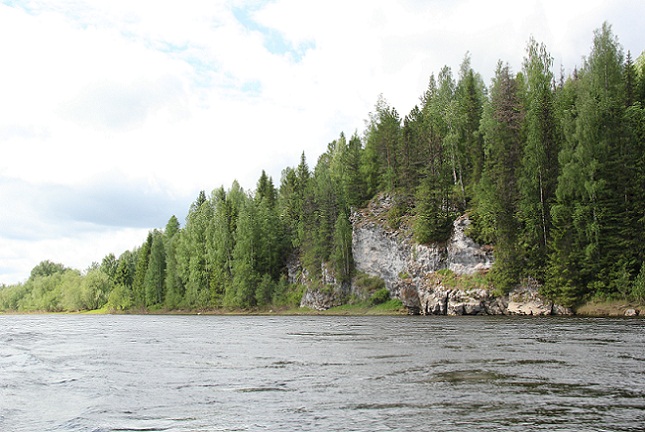Visit to Pechora-Ilych Reserve
The Silver Taiga Foundation employees have come back from a week-long business trip to the Pechora-Ilych Nature Reserve. The objective of the trip was to prepare the routes for the new educational season, but not only that. It was also important to introduce the young foundation employees to the peculiarities of the natural processes taking place in the taiga forests and deepen their knowledge about the pristine forests and forest biodiversity conservation. The colleagues have willingly shared their impressions of the trip.
Alexander Borovlyov, a GIS-specialist:
“This is the first time that I visited such a unique place and was simply enchanted! For the first time I had the opportunity to observe the ecosystems peculiar to this territory and learned a lot of new information from the field courses of Yury Anatolyevich Pautov, got acquainted with new interesting people – the employees of the Centre for Problems of Ecology and Productivity of Forests, Russian Academy of Sciences (CEPL RAN). For the first time I sailed on a boat for such a long time. It’s a very exciting feeling when you’re almost on the water level and only four boards separate you from the rapid Pechora! At the same time – when you look around and see a wonderful landscape – the foothills of the Urals, cliffs – you feel peace! The reserve demonstration routes have given me a more complete picture of the natural reforestation. I’ve made sure that this is not a linear process, but the ecosystem that can develop in various ways. We have gone through several forest routes. Some of them are easy, other – more complex, but all of them are simply unique! What is surprising is that I was not in the least tired. The fascinating stories of Yury Anatolyevich and the magnificent views have had their effect! 8 hours on the route went by unnoticed. The tourist routes will be interesting and very useful for the people working in the field of forest management, students of natural scientific specialties. Undoubtedly, this experience will help me to better understand and further study the issues related to the natural forest dynamics.”
Nikolay Shuktomov, a forestry coordinator:
“I was mostly impressed by the elk farm, because there I got a chance to communicate with wild animals, which are seldom to meet in our everyday life. Elks are very strong and graceful animals. They are dangerous in the wild-life conditions, but are relatively easy to tame. This contrast is interesting for me. One more thing that struck me was the dedicated people working in the reserve. They know and love their work. I advise to everybody to go on an excursion to the elk farm and try to befriend these wonderful animals.
I was amazed by the mountains, cliffs along the banks of the rivers. When you see them you understand how ancient and powerful this process is. Your inner explorer awakens and you want to discover new places, where no human has set foot for millenniums, to find the remains of ancient animals. It is simply breathtaking when you are standing on a stone balcony over the precipice of 30 – 40 meters with a picturesque view of the Cis-Ural region in front of your eyes. These are very valuable places for rock climbing lovers. Personally I regretted that at that moment I didn’t have climbing equipment with me.
Of course, we faced some difficulties during this trip, how can it be otherwise! For example, abundance of mosquitoes, remoteness from the civilization, ascetic living conditions. However, there is some special romance in it that makes us visit such places. These routes are very interesting and unique, but require special knowledge and certain skills of work in the field conditions. When I started to work in the Foundation, I realized that I had gaps in my knowledge about forests. During this trip I filled them with the examples of natural processes of the taiga forests development.”
Nikolay Shilov, an educational coordinator:
“I was particularly impressed by the abundance of the red-listed animals and plants. I understood that the forest dynamics in the landscape is much more complex than I had previously thought. I learned a lot of new things about the foothills forests.
The work of the reserve specialists commanded respect. Despite limited funding and tough conditions, they do their work with interest. There were some inconsistencies that occurred when we were passing the routes: for example, some direction signs were installed incorrectly. The reserve forest routes are quite specific and may be of interest and of great benefit mainly for the students of the specialised educational institutions and forest industry employees.
The field conditions presented no special difficulty for me. In fact, we had some questions regarding the quality of the guest houses, untended territory around them, lack of electricity at the cordons, and all this was discussed with the reserve employees.”
Sergey Davydov, a driver:
“I’ve been struck by the richness, uniqueness and diversity of nature, breathtaking scenery that we have seen from the high coastal cliffs, fabulous views of the mountain range. As an amateur photographer I’ve taken plenty of photos, collected a rich photographic material. Besides, the CEPL employees have shared their materials of night shooting of unique animals in their natural environment!”
We asked the Foundation Director Yury Pautov to sum up the impressions of the Silver Taiga employees having visited the reserve and to answer a few questions.
– Yury Anatolyevich, why do you consider it important to familiarise the young employees with the reserve routes? How will this trip contribute to the implementation of our projects?
– We created these routes in 1997-1998 in the framework of the WWF project “Sustainable management of northern forest: Pechora-Ilych model project”. On the one hand, the main purpose of these routes was to show the uniqueness and peculiarities of the natural taiga processes ongoing without a human intervention, and also demonstrate why these processes are so important, for example, for the conservation of the boreal forests biodiversity, for maintaining the ecological functions of the landscape, and for the nature conservation in general. On the other hand, it is important to see and show by relatively short routes the processes linked to the centuries-long changes in the taiga. Usually people do not see them and perceive forest as a fact of life, with no dynamics, but actually these processes are ongoing all the time – and our routes are designed in such a way as to be able using this mosaic to create in the minds of people a full picture of how the natural pristine forest has been living for millenniums without a human intervention. Normally, people see forests near cities and villages, or relatively exploited forests in the places where there is a road. They see the forests that change mainly as a result of a human influence: they are logged, burn down, new roads are built there, people pick mushrooms and so on. Here all changes happen by themselves, without a human influence.
The purpose of these routes is to show that forest is worthwhile in itself as a huge habitat for a wide range of animals, plants, microorganisms – everything that is called biota, including people.
Over the 20 years since our first visit to the reserve, these routes have been visited by a great many forest industry specialists, ecologists, foresters, environmentalist from all kinds of places, but most of all from abroad. Many foundation employees have also visited the reserve. We have recently recruited new employees, who have not visited these routes so far. They already know a lot of things, they have listened to the lectures on pristine forests, biodiversity, but they have not yet seen such undisturbed nature. It’s better to see once than hear a hundred times, so we decided to consolidate this theoretical knowledge. Certainly, the foundation employees engaged in studying the forest biodiversity, conservation of forest biodiversity, preservation of pristine forests, certification issues related to HCVF, need such knowledge. I hope that after visiting these routes this theoretical concept will take a practical shape in their head, and they will be able to use these examples, these samples in their practical work, including lecture and practical courses for the most diverse audiences.
– This is not your first visit to the reserve. Do you have any vivid impressions associated specifically with this trip? Maybe there was something most memorable, maybe there was something new even for you…
– Yes, of course, each trip brings something new! For example, the first big news for me, as the person connected to the reserve for more than twenty years and knowing a large number of its employees and representatives of the administration, was a substantial change of the reserve staff. The staff has changed almost by 70 %, if not more. There are almost no employees left with whom we prepared these routes and organized courses. I cannot say whether it is good or bad, but it was a news for me.
The second news is that the routes, that we developed at the end of the 90s for the educational courses, now have become a kind of object of ecological tourism not only for the specialists brought by the Silver Taiga Foundation, but also for the reserve itself. When creating these routes, we had extensive debates with the reserve science division. We discussed the feasibility of the routes and the potential of such tourism in the reserve in general. At that time the opinions divided, as half of the scientific staff considered that the reserve was a closed territory where nobody should be allowed to enter, the territory for nature, whereas the other half of the employees said that it was possible to have a look from a distance, but only in such a way as not to disturb anything, not to interfere anything, not to shout, not to shoot, not to catch, not to pick, not to leave traces and so on. However, the first several courses held in reserve showed that after 20 people passing through the forest a trail was formed anyway, noise appeared, boats were sailing along the river, etc. Back then, it was quite an intense discussion. Gradually, the scientific staff got used to the fact that specialists from different parts of Russia and other countries came to get acquainted with the taiga life. Then the feasibility of the environmental tourism introduction on the reserve territory was discussed. On the one hand, the reserve is the most strict form of nature protection in Russia, and, by definition, it does not allow the ecological tourism, this is really a wildlife zone. On the other hand, plenty of reserves are located near urbanized areas and in one way or another experience such influence. Therefore, in 2000s, the discussion on the feasibility of the ecological tourism introduction started already at the national level. It was discussed that the reserve should serve not only for the nature, but also for people. Today, many reserves develop their own environmental courses, excursions, sightseeing tours. The Pechora-Ilych reserve started to implement the same. Quite recently, when the weathered pillars on the Man-Pupu-Ner Plateau were included in the list of 7 Wonders of Russia, visits of organized groups guided by the reserve employees were arranged there.
Currently, the forest routes, developed by the foundation staff, are being equipped, including installation of direction signs and arbours, construction of walkways through the rough terrain, wetlands, brooks, and lowlands, arrangement of viewing platforms. A new guest house was built in the village Yaksha and one more, able to accommodate up to 20 people, – at one of the cordons – on Shezhim. This is exactly the implementation of what we have been talking about for the last 20 years. Now they have started this activity, which greatly facilitates holding of such educational courses. For example, now a guide or a group don’t need to care about tents or firewood during the cold season; many routes are equipped with direction signs helping to easily orient themselves while in the forest. There are, of course, some omissions, but as in any great job, this is quite acceptable and needs to be worked at. For example, some direction signs on the routes and demonstration points have been attacked by a bear: probably, they are moistened with a liquid which attracts bears, or there are some other reasons. Obviously, this should be changed somehow, because bears visit those places more often than people and will do this just for fun or out of curiosity.
Another pleasant impression is related to the fact that every time we visit the reserve, we encounter some manifestation of wildlife, in particular, large predators, large mammals. Last time we saw wild reindeer and an elk directly on the river. This time we saw a flying and hunting white-tailed eagle, we saw an osprey three times. We saw a bear swimming across the river; although it was a small one, it was so thrilling and pleasant to watch it. Moreover, we managed to come close to it, at the distance of 10 – 15 meters, and it was not afraid at all. Such meetings happen regularly. We constantly see beavers, different ducks, woodpeckers. We’ve met wood grouses, and this year we found a wood grouse’s egg laying place and alarmed a wood grouse hen.
– What, in your view, is the potential of the ecotourism?
– That’s a tricky question! The reserve is located very remotely and, therefore, only very enthusiastic and motivated people can go there on holiday in order to satisfy their interest in nature or some places of interest (not including the Man-Pupu-Ner, which has become quite popular).
The second aspect is that due to various historical reasons the territory of the reserve is split into two unequal parts. The main part, a foothill one, is in a hard to access area, which can be accessed only by boat. Such journey requires a lot of efforts and time and considerable funds, but it is there that you will see the wild undisturbed nature and it is there that you can realize the true extent of what is being protected, preserved, and understand the importance of these processes. As for the small part located in the village Yaksha, it is much more accessible, but there is only one landscape complex including the pine forests, lichen pine forests, and adjacent flood plain of the Pechora river preserved there. It is approximately one tenth of what the reserve has. There are also an elk farm and a museum there, but it is only for one or two time visit. In my opinion, if a person is going to visit a reserve in order to take a closer look at the wildlife, he/she prepares for a long journey, at least for one week. In my estimation, currently the reserve is not ready to organize such week-long high quality tour rich in activities. An acquaintance with the part of the reserve in Yaksha takes two – three days and, considering a long trip, it turns out that such journey makes no sense.
Yet the greatest difficulty lies elsewhere… The reserve employees prepare demonstration materials, they have renewed the elk farm and put in order a lot of things. Now they have additional female moose that bring forth every year, some baby moose are very friendly and sweet. However, in my view, the most significant aspect is missing – I mean the people able to skilfully, competently and passionately explain what the reserve is, what its activities are, what is going on in the forest, on these routes, etc. In other words, there are no trained guides and developed programs, which could help to attract a large number of tourists. Many tourists come here out of curiosity, it seems that the current reserve staff has enough knowledge and experience for such unprepared people, but as for the trained specialists, in my opinion, it is insufficient. By this I mean that unprepared tourists will go only to Yaksha and will study the little that is represented there. As for the trained specialists, they will not go anywhere yet, because there is no one to present them all this diversity, which is included into the World Heritage Sites under the name of the Virgin Komi Forests
This is, however, the main schtick of the reserve – it preserves undisturbed forests. There are no such large massifs of undisturbed forests preserved in the European part of Russia, and in Europe in general. That’s exactly why the specialists go there, but there is no one who can show it. The situation can be compared with the one in which you would come to another country, to an unknown city, and somebody would tell you that there is, for example, the Dresden Art Gallery there and you can go to this gallery and study everything by yourself using a guidebook in Russian. A knowledgeable person will, of course, find the artworks of Velasquez and Rembrandt and many other masterpieces and will be able to see and appreciate them, but an amateur first-timer will walk among this variety of paintings of great artists and will not to be able to appreciate the uniqueness of this place. The reserve has the richest natural potential, as for the human potential – it is food for thought…!
The material has been prepared by Anna Mikheeva
The photos are made by Sergey Davydov and Vladimir Kalmykov

